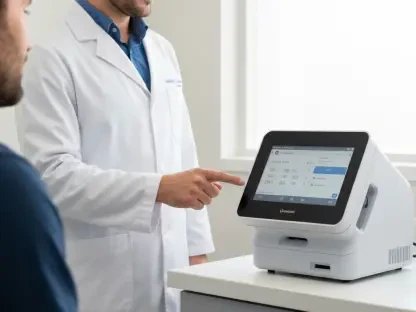The landscape of neurology is undergoing a seismic shift as new advancements in research and treatment redefine approaches to longstanding neurological diseases. Historically, the focus has been on managing symptoms, often overlooking deeper disease mechanisms and progression. Today, this is changing. Driven by new therapies and a more holistic understanding, neurology is increasingly prioritizing neuroprotection and integrated patient care. With improved technology and strategic funding, the field is moving toward patient-centric models that aim to enhance health outcomes significantly. Against this backdrop, it is essential to delve into the intellectual and practical evolution transforming this area of medicine.
Evolving Neurology and Neuroinflammation Therapies and Trials
Reimagining Neurodegeneration and Treatment
In the realm of neurology, especially for disorders like multiple sclerosis (MS) and Alzheimer’s, the emphasis has traditionally been placed on the alleviation of symptoms. However, recent discoveries have highlighted the limitations of this approach, demonstrating the need for treatments that address underlying disease processes. For instance, in MS, the link between immune dysfunction and progressive neurodegeneration has brought to light the inadequacies of solely focusing on relapse treatment. This has led researchers to explore mechanisms of neuroprotection, an area that promises more comprehensive therapeutic strategies aimed at preserving nerve function and delaying disease progression.
The recognition of smoldering neurodegeneration—unaffected by conventional anti-inflammatory treatments—emphasizes the necessity for early intervention strategies that prevent nerve damage before it becomes clinically apparent. As scientists continue to unravel the intricacies of neurodegenerative diseases, there’s a shift toward integrating biomarkers like neurofilament light chain (NfL) and novel imaging technologies into clinical practice. These innovations are paving the way for treatments that better identify and monitor neurodegenerative processes, facilitating a transition from symptom-focused care to approaches striving to modify disease trajectories.
The Shift from Relapse Treatment to Neuroprotection
Multiple sclerosis serves as a prime example of the shifting therapeutic landscape as stakeholders recognize the insufficiency of traditional symptom-centric management. Research increasingly underscores that extending beyond relapse mitigation alone poses a compelling opportunity for improving long-term patient outcomes. By addressing smoldering neurodegeneration, therapeutic interventions can potentially reduce the advancement of disabilities associated with MS. Practitioners are now re-evaluating treatment strategies, with a strengthened focus on initiating therapies earlier to protect neurons as a preventive measure.
New methodologies provide unprecedented opportunities for differentiating between inflammatory issues and genuine neurodegeneration. Importantly, these insights are fostering an era where treatment progresses toward improving neurological health by tackling neurodegeneration proactively. Clinicians are exploring novel compounds and treatments geared toward altering the natural course of the disease, heralding more personalized and effective therapeutic options. Through this evolved understanding and targeting of MS pathology, researchers hope to transform the prospects of patients living with chronic neurological diseases, potentially delaying or even halting disease progression altogether.
Patient-Centric Therapies on the Rise
Addressing Diverse Patient Needs
The world of neurology is shifting toward more patient-driven paradigms, focusing on elevating the patient’s role in treatment decisions. This evolution represents a departure from traditional drug development, which prioritized clinical trial endpoints over patient preferences. Such approaches often neglected the nuances of daily life and the changes patients desired most. As a result, there is now increased emphasis on patient-reported outcomes, which align medical interventions with actual patient needs, ensuring treatments offer holistic benefits that extend beyond clinical measurements.
Ease of use and adherence are becoming pivotal considerations in therapy choice, driving demand for more convenient treatment modalities, such as oral or once-daily medications. Patients and providers alike advocate for treatments that integrate seamlessly into daily routines, as adherence significantly determines therapeutic success. As stakeholders increasingly prioritize patient satisfaction, pharmaceutical developers are tasked with innovating products that balance efficacy with lifestyle compatibility, promoting sustained medication use and thereby enhancing outcomes.
Regulator Emphasis on Patient Experience
Regulatory agencies are adapting to the growing focus on patient-centered care, incorporating patient experiences into their assessment and approval processes. This evolution underscores the importance of transparently assessing both traditional endpoints like safety and efficacy and newer considerations such as quality of life and treatment satisfaction. By embedding patient feedback into regulatory criteria, agencies aim to facilitate the development and dissemination of treatments that resonate with patient experiences and needs more closely, thus creating a more inclusive healthcare environment.
As therapeutic candidates progress through clinical trials, stakeholder collaboration becomes paramount to ensure patient voices influence every development stage. Engaging patients from early trial phases aids in the identification of meaningful endpoints and guides the formulation of user-friendly administration routes. Such interactions are crucial affirmations of the field’s shift toward holistic assessment methods that value and respond to human emotion and experience alongside measurable clinical outcomes.
Funding Growth for Brain Health Research
Enhanced Investment Strategies
Financial strategies underpinning neurological research are experiencing a marked shift, gravitating towards investments that prioritize significant breakthroughs over incremental gains. Several factors drive this trend, including heightened awareness of the complexities of neurological diseases and the potential societal impact of advancements in these areas. As a result, investors now focus on therapies with long-term significance, addressing unmet medical needs with the potential for transformative change. This tacit understanding underscores their strategic choices, channeling resources into research projects demonstrating realistic prospects for considerable patient impact.
For firms specializing in neuroprotection and disease-modifying therapies, this evolving investment climate offers fertile ground for growth and innovation. Investors, regulatory bodies, and research institutions are increasingly consolidating efforts to identify and support high-potential projects. It is becoming increasingly evident that collaboration in understanding and tackling neurological challenges is key to pioneering significant progress in the field.
The Role of Entrepreneurial Engagement
Entrepreneurial initiatives within neurology have taken on a crucial role as startup firms and independent ventures champion cutting-edge research and development efforts. In this climate of heightened investor scrutiny, novel ideas and approaches hold special appeal, propelling creative solutions for age-old problems. Young companies are often more agile, enabling swift adaptation to emerging trends and fostering groundbreaking ideas. At the same time, regulatory frameworks encourage calculated risk-taking, promoting the exploration of innovative therapeutic pathways that may have otherwise languished as niche interests.
However, sustained success requires careful navigation of industry challenges and maintenance of scientific integrity. While entrepreneurial ventures contribute to the excitement and dynamism permeating the field, confident engagement with oversight bodies and a commitment to rigorous scientific validation ensure products withstand scrutiny. If these elements coalesce harmoniously, the potential for sweeping advancements in neuroprotection, patient care, and overall neurological health becomes increasingly attainable.
Harnessing Technology for Drug Discovery and Clinical Trials
Integrating Artificial Intelligence and Machine Learning
The escalation of technological advancements holds profound implications for nearly all facets of medical research, drug discovery, and clinical care. Artificial intelligence (AI) and machine learning (ML) are at the forefront of this revolution in neurology, ushering in an era of time-efficient discovery that targets specific patient needs. These technologies augment traditional research methodologies, providing deeper insights into disease mechanisms and enabling the discovery of drug candidates with higher specificity and efficacy.
AI and ML allow researchers to sift through massive datasets rapidly, identifying patterns and connections that might remain obscured through conventional analysis. This capability is pivotal for early drug discovery, where AI-driven models can predict potential compound efficacy with far greater accuracy. Consequently, AI and ML foster a more targeted approach to drug development, minimizing the likelihood of failure in costly later-stage trials.
Transforming Clinical Trial Designs
The integration of technology transcends drug discovery and extends into reimagining clinical trial designs, making them more reflective of real-world patient populations and experiences. Decentralized clinical trials represent a significant departure from traditional models, leveraging digital technologies to reach a broader patient base. Remote monitoring tools and digital data collection platforms enhance trial accessibility, particularly for patients whose neurological conditions involve mobility challenges or geographic barriers to participation.
Given the inclusive nature of decentralized trials, researchers gain a more nuanced understanding of the drug’s performance across diverse groups, enabling revisions to refine therapeutic approaches. Adopting these technologies fosters more representative and ethically-informed research practices. Concurrently, the emphasis on transparency ensures clinicians and patients remain actively engaged in interpreting data and translating findings into innovative clinical applications.
Overcoming Challenges in Accessibility and Affordability
Addressing Cost Barriers
Despite significant progress within the neurology sector, high costs associated with new treatments present a significant barrier to patient access. Bridging the gap between groundbreaking therapies and the individuals who need them most is crucial to translating scientific progress into tangible societal benefits. Strategies to address affordability are already in discussion, with efforts to streamline manufacturing processes and encourage development efficiencies underway. Within this context, policy initiatives aim to make biologic therapies more economically viable. Collaborations among stakeholders—including regulatory bodies, healthcare providers, and pharmaceutical companies—have been key facilitators toward more economically accessible treatment methods.
Policymakers are working on initiatives designed to reduce costs and enhance patient access to transformative treatments. This involves encouraging competition and promoting generic drug development and approval, which could significantly ease financial burdens on patients and healthcare systems alike. Similarly, shifts toward small molecule drugs, rather than biologics, create additional opportunities for cost-effective scaling and distribution, as these are typically simpler and cheaper to produce and distribute.
Manufacturing Scalability and Global Accessibility
Efforts to expand treatment distribution align with broader industry desires to achieve greater manufacturing scalability, particularly for complex biologics and next-generation therapies. Embracing advances in biomanufacturing processes and supply chain optimization is poised to enhance treatment availability significantly. By prioritizing scalability in the production of biologic treatments, the neurology field positions itself to address global patient needs more efficiently.
Small molecule therapies, recognized for being easier and faster to produce, present additional advantages, offering scalable solutions that can meet global demand. These approaches are being particularly encouraged as part of broader strategies to ensure clinical breakthroughs reach diverse populations and reduce health inequities. Ultimately, the intention is to ensure groundbreaking treatments have the widest possible reach, translating scientific ingenuity into actionable global health improvements.
The Path Forward
The field of neurology is experiencing a monumental transformation, as pioneering research and cutting-edge treatments reshape the understanding and management of enduring neurological disorders. Traditionally, the emphasis was largely on alleviating symptoms, often neglecting the underlying disease processes and their progression. However, this traditional approach is now being revolutionized. Fueled by innovative therapies and a comprehensive, holistic understanding of neurological conditions, there is a growing emphasis on neuroprotection and integrated care for patients. This shift is driven by advancements in technology and more strategic allocation of resources, pushing the field towards models centered on the patient experience and outcomes. This approach aims to significantly improve health results for those affected by neurological issues. In light of these developments, it is crucial to explore both the intellectual evolution and the practical aspects that are reshaping neurology’s approach to treatment and patient care. Such exploration will enhance our understanding of how these changes are poised to benefit both patients and the broader medical community.









